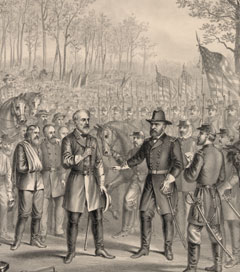It’s the 150th anniversary of the start of the Civil War in the United States, and The New York Times has launched a special blog, Disunion, covering the events in “real time” — day by day, as they happened in 1861. Great stuff.
But I’ve long had a special fascination, not with how the war began, but with its end. On March 29, 1865, Phil Sheridan, a Union army general, began the flanking movement that culminated, just 11 days later, in the surrender of Robert E. Lee at Appomattox Court House in Virginia.
Why do I find this final campaign so fascinating? Partly because the battles of the Five Forks campaign in Virginia ended up involving some of the very same players who famously fought at Gettysburg, Pa., in 1863: heroic action, once again, by Joshua Lawrence Chamberlain, and the Confederate force destroyed at Five Forks was led by none other than George Pickett.
But mainly, I think, it’s because of the symbolism of that final surrender: General Lee, the patrician, in his dress uniform, surrendering to the not at all patrician Ulysses S. Grant, commander of the Union forces, still muddy and disheveled from hard riding. It was, in a very real sense, the victory of modern America — of a democratic nation, in manners as well as politics — over an aristocratic ideal.
And the way modern America won was characteristic. Southerners were better warriors — man for man, they almost always outperformed Union armies, although the gap narrowed over time. But the North excelled at the arts of peace — that is, in industry and ability to get things done. The North couldn’t stop Bedford Forrest from raiding supply lines; but it could repair track incredibly fast. And it was that Northern superiority in logistics, in production, that eventually proved decisive.
America’s other great moral war, World War II, was similar. The war movies I watched when I was a kid always had plucky, individualistic American heroes beating superbly equipped Nazis, but the reality was mostly the other way around. We had many heroes, but the truth is that Americans were never as good at the art of war as the Germans. What we were good at was the art of production, of supply. Honor the heroes who stormed Omaha Beach — but it was the floating harbors, the trans-Channel fuel pipeline, and the air superiority achieved through production miracles that really did it.
So, anyway, I’m thinking about the muddy roads south of Richmond, Va., where, 146 years ago, the seal was put on creating the kind of nation I believe in.
Truthout has licensed this content. It may not be reproduced by any other source and is not covered by our Creative Commons license.
Paul Krugman joined The New York Times in 1999 as a columnist on the Op-Ed page and continues as a professor of economics and international affairs at Princeton University. He was awarded the Nobel in economic science in 2008.
Mr Krugman is the author or editor of 20 books and more than 200 papers in professional journals and edited volumes, including “The Return of Depression Economics” (2008) and “The Conscience of a Liberal” (2007). Copyright 2011 The New York Times.
Join us in defending the truth before it’s too late
The future of independent journalism is uncertain, and the consequences of losing it are too grave to ignore. To ensure Truthout remains safe, strong, and free, we need to raise $43,000 in the next 6 days. Every dollar raised goes directly toward the costs of producing news you can trust.
Please give what you can — because by supporting us with a tax-deductible donation, you’re not just preserving a source of news, you’re helping to safeguard what’s left of our democracy.
